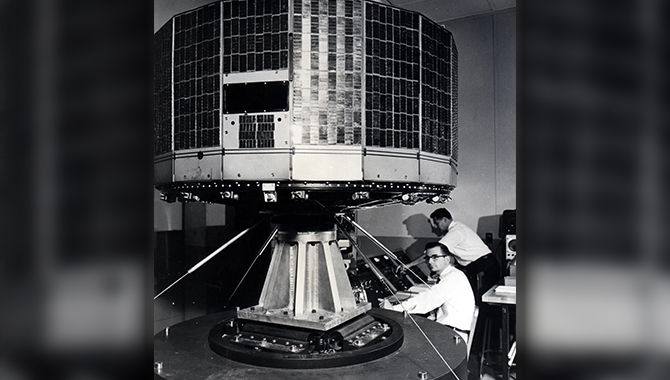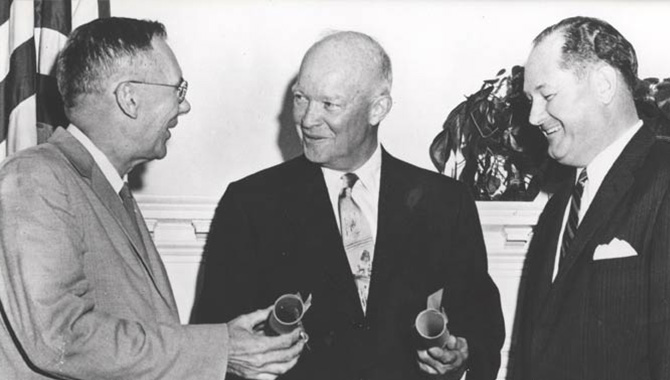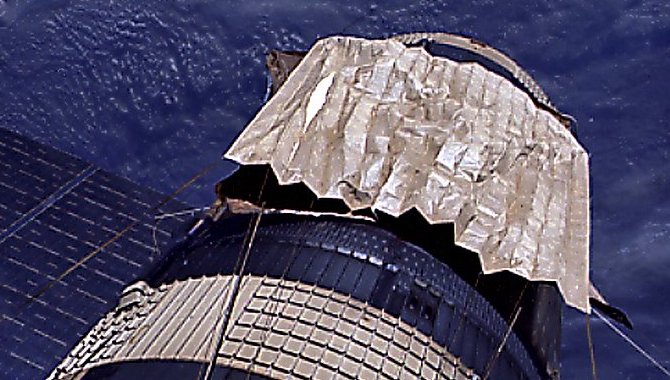
The sunshade deployed by the crew of Skylab 3 showing the folds Pilot Jack R. Lousma wrestled with in zero gravity.
Credit: NASA
The crew of Skylab 3 made crucial repairs to the space station and dramatically pushed the boundaries of time in space.
This month, 45 years ago, Commander Alan L. Bean, Pilot Jack R. Lousma, and Science Pilot Owen K. Garriott, splashed down 230 miles southwest of San Diego, ending what was then the longest human space flight in history. Early in the mission, however, it wasn’t a foregone conclusion they would reach the scheduled 59th day.
The crew of Skylab 3 blasted off aboard a Saturn IB rocket from Kennedy Space Center on July 28, a date that was moved forward three weeks to better facilitate repairs to the Skylab. The crew of Skylab 2 had made vital repairs to compensate for missing portions of the micrometeroid shield that were torn away when it deployed prematurely. The parasol they deployed, however, was still allowing internal temperatures to be uncomfortably hot.
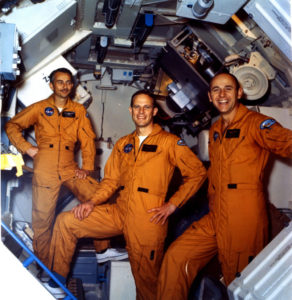
The crewmembers of Skylab 3: astronaut Alan L. Bean, foreground, commander; scientist-astronaut Owen K. Garriott, left, science pilot; and astronaut Jack R. Lousma, pilot. This crew spent 59 days and 11 hours in orbit.
Credit: NASA
The Skylab 3 crew was to deploy a sunshade on two poles to augment the parasol. They also were carrying replacement gyros to stabilize the space station. But before the capsule could dock with Skylab, the crew faced a fuel leak that required shutting down two of the four thruster quads.
“I was sitting in the middle, Alan on my [left], Jack over here. As we were proceeding through the middle of the rendezvous… Jack said, “Look at that.” I looked out his window over here, and here came what looked to be the nozzle of one of the reaction control thrusters just floating by the window,” recalled Garriott.
The propellant line to that nozzle had sprung a leak. As the leaking fluid gathered at the nozzle and froze, it took the form of the nozzle. Eventually, it broke loose. “So, what floated away was an ice sculpture of that reaction control thruster,” said Garriott, in an oral history. This cost the crew not only the leaking thruster, but one on the other side, to maintain symmetrical thrust. The crew was able to compensate for the lost thrusters and successfully dock with Skylab.
Skylab 3’s fuel leaks were not over, however. On day six, while the crew members were looking down on an aurora over New Zealand, they saw the curious sight of snow passing by the window of the capsule.
“Boy, a real blizzard came by,” Garriott recalled. “Well, since it doesn’t snow very much in space, we realized there had to be another explanation, and in this case it was obvious we had another fuel leak.”
With three thrusters out of commission, NASA began serious discussions on the option of launching a modified rescue capsule to dock with Skylab and return the crew. “That was a concern, because you know if we had one failure during rendezvous and another failure on day six, when’s the next failure going to occur? Obvious question. It took some time for the ground to try to figure out why did the failure occur. Is it systemic? Are we going to have a continuous sequence of failures, or is it just random occurrences?” Garriott said.
Eventually the crew was cleared to stay the full 59 days, replacing the gyroscopes and deploying the sunshade. The sunshade was anchored by two 55 ft. long poles, assembled from 5 ft segments. Lousma recalled that, standing outside Skylab with his feet anchored, “you could whip [the poles] like a fishing rod.”
With the poles secured, Lousma used ropes on each pole to deploy a 24 ft. by 24 ft. sheet that was folded into a duffel bag at his feet. The sheet was fabricated in a matter of days and delivered to Skylab by the Skylab 2 crew. It had been folded while the adhesive holding the panels together was still tacky, and some of the folds stuck together, Lousma recalled in an oral history.
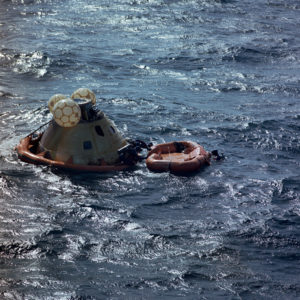
A team of U.S. Navy swimmers assists with the recovery of the Skylab 3 Command Module following its splashdown in the Pacific Ocean about 230 miles southwest of San Diego, California.
Credit: NASA
“The doggoned sheet was not spreading out in a nice flat plane like it was supposed to,” Lousma said. “In fact, what it was doing was sticking together and … causing the poles to bend inward.” This meant the sheet wasn’t covering the workshop, leaving it vulnerable to solar gain.
“So, what I had to do was I had to [reel] all of this sheet [back] in toward me and separate all those folds and unstick them. …This thing was billowing up everywhere and just doing all kinds of acrobatics over my head in zero gravity and almost out of control, but it was still fastened to the rope. …Every time I’d touch it, it would do something else,” Lousma said.
Although the mission was full of drama and uncertainty, its legacy was how it advanced scientific understanding of the effects of zero gravity on the human body over nearly two months. Crew members were monitored for changes to their cardiovascular, neurovestibular, and musculoskeletal systems. The crew spent more time performing exercise based on lessons learned from the Skylab 2 crew.
The crew completed more than 300 hours of science experiments during the mission, fighting off an early bout of motion sickness.
“So, the long-duration mission is not like a camping trip,” Lousma said. “…You have to … prepare yourself psychologically. You’re there for the duration. You have to really become a space person, because your body adapts to different elements of being in weightlessness at different rates.”
“…That was one of the things we were trying to determine in Skylab, — can the body stay in [a] weightless condition for long periods of time, do useful work, and be productive, or will it have to have a rotating Space Station with artificial gravity and all the expense and complexity that goes with it? So we were able to demonstrate in the Skylab that at least long-duration missions up to three months were feasible and that we could actually perform and do useful things…”






